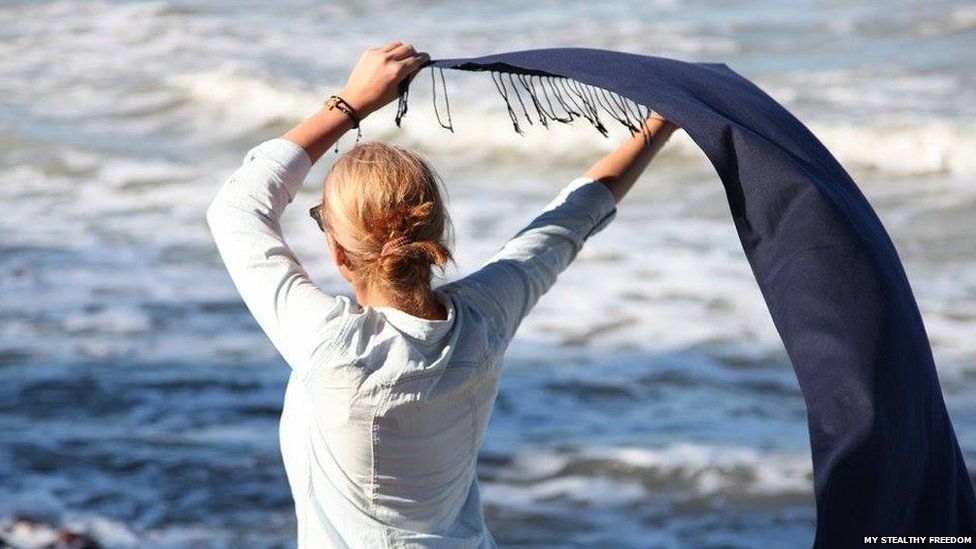100 Women 2015: Iranian women's fight for freedom
- Published

Iran is better known for its religious conservatism than its history of women's rights. But although it might not be obvious to outsiders, the feminist movement in the country has a rich and varied history.
As well as having the right to vote, many women are members of parliament in Iran. Unlike Saudi women they are allowed to drive. They also work and participate in economic life. Most significantly, women make up more than 70% of students in Iran.
But these freedoms were not achieved without the struggle and sacrifice of many extraordinary women.
It is often said that education holds the key to freedom, something understood by early Iranian feminists like Bibi Fatemeh Estarabadi.
During the Constitutional Revolution of 1905 she opened the country's first primary school for girls, teaching everything from maths and literature to calligraphy and history.
She faced fierce opposition from conservative clerics who accused her school of harbouring corruption and indecency. But she battled on, giving many young women a voice and a future.
Few women used their voices to such powerful effect as Ghamar ol Molook Vaziri. She was born just one year before the Constitutional Revolution and began singing as a child, learning religious mourning songs with her grandmother.
By the age of 20 she was challenging - and changing - Iran's male dominated music scene.
She performed on stage without the hijab at a time when women who did not wear a headscarf were often taken to jail.
Ghamar ol Molook Vaziri
In 1924 she decided to sing on stage in Tehran's Grand Hotel, opening the door for many women to do so after her.
Sixteen years later the first radio signals were transmitted in Iran and the public finally heard Ghamar's voice. She remains an icon of rebellion and independence to this day.
But it wasn't just through song that women made their voices heard. Literature had long been a way for them to tell their stories, voice concerns and challenge the status quo.
One woman's poetry did more to shake the world of Farsi literature than any before - or since.
Forough Farrokhzad
Forough Farrokhzad's poems are bold, honest and open.
She married a famous satirist, Parviz Shapour, at the age of 16. They had a son but their marriage ended after only two years.
In the conservative, religious society of Iran, Farrokhzad was a controversial character; a divorcee writing poetry and voicing her rage at the limitations on women.
She called for liberation and freedom and gave the women of Iran a glimpse into a world in which they could have both.
Tragically, Farrokhzad died in a car crash at the age of 32.
When the Islamic Revolution came in 1979 many of the freedoms that had been slowly and painfully won by women in Iran were swept away. A new, more conservative orthodoxy allowed the clerics to regain much of the control they had lost.
Ironically, Iranian women had a huge role in fomenting the revolution. Women from different backgrounds - religious women, leftists, housewives and students - took to the streets shoulder to shoulder with men demanding that the Shah leave the country.
When the US embassy was overtaken and many taken hostage, one of the leaders of the siege was a woman, Masoumeh Ebtekar. She was educated in the US and is now the head of Iran's Environmental Protection Organization.
Women in Iran supported the revolution in the hope of more freedom and independence. But it soon became clear they had won neither.
The leadership quickly declared that women in all government organisations and public spaces had to wear the hijab, a law many have have been protesting ever since.
But small acts and protests have gradually regained lost ground. Boundaries have been pushed with the hijab. Many women now wear brighter colours and looser headscarves, transforming what was supposed to be a grim, modest uniform into a fashion statement.
Masih Alinejad
Like many women before her, Masih Alinejad, an Iranian journalist and blogger, used the tools at her disposal to protest the compulsory hijab.
She launched an online campaign called "My Stealthy Freedom" encouraging women to publish pictures of themselves without their headscarf.
Individually it was just a little protest but combined it became a global movement.
But not all icons of Iranian feminism chose their fate.
The captain of the national football team, Niloufar Ardalan, became a reluctant feminist icon after telling the world that her husband had banned her from travelling abroad to play in a tournament. He refused to allow her to apply for a passport.
Inadvertently, she demonstrated the injustices even the most famous women can suffer.
In September 2010 Masoumeh Ataie was attacked with acid by her father-in-law. She was blinded and terribly scarred but found the strength to fight for custody of her son.
She became a vocal campaigner for the victims of acid attacks, bringing attention to other victims and giving them the voice others had tried to deny them.
Iranian acid attack victim Masoumeh Ataie. Footage courtesy of My Stealthy Freedom.
Throughout the past century the path to equality and recognition for Iranian women has not been an easy one.
Many have challenged the status quo and succeeded, only to lose it again to force and brutality.
Throughout history Iranian women have never given up. They continue to inspire and aspire, proving that they are and always will be a major force for change.